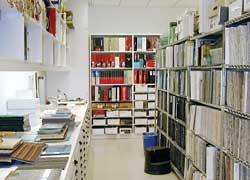The Art of Product Research and Selection
Internet
Searching the Internet has positive and negative aspects. Web searching does not always yield exact results, but construction industry search engines are sure bets because they pre-select interesting items. Tinmouth often bookmarks websites, and prints out pages to add to a project file. If the product has widespread use, he will call the sales representative for literature and product samples. Everyone in Helfand's office does product research, but individual styles and methods vary, especially during each project phase. Sometimes, web surfers stumble on leads for items potentially useful on future projects.
The downside of Internet searching, especially with search engines, is finding many irrelevant websites and false paths, due to lack of specificity. "We can go to the well-known, multi-volume catalogues and look at flooring. A web search can yield short stories on flooring, which is not what we want," says Tinmouth. Industry sites are among the sure bets, because they feature links to manufacturers. Another downside of Internet searches is that colors on the computer screen don't translate exactly, and samples are needed to review exact color matches. Estimates vary from 30 to 50 percent, or even 80 to 90 percent, of time spent searching the Internet is unproductive. PDF files are easy to download and print, especially for specifications and brochures. Many design professionals prefer PDF files for finding product size, strength, flame ratings and other technical data, and print pages to add to the project manual and outline specifications.
Project Phase Styles and Methods
Searching preferences reflect an individual's style, as well as project needs within each phase. Design and construction projects are typically performed in five phases, as outlined in standard agreements: schematic design, design development, construction documents, bidding and negotiation, and construction. Depending on the project size, building type, architectural office size, client needs, project delivery method, budget, and other factors, many people with different skills and job titles may be involved with product research, selection and specification throughout a project.
Schematic Design and Design Development
At the project outset, during the schematic design and design development phases, many architects cast a wide net to see what kinds of products are available. Samples are often requested during schematic design, to give designers a clear idea of how a product looks and feels. Color selection is not necessary at the early stage, and generally occurs later. Many architects find CAD details provided by building product manufacturers to be extremely helpful during the design development and construction documents phases.
|
Construction Documents
From the design development phase and into the construction documents phase, searches generally involve alternative products and more specific information, such as color, size and usage. When construction documents are under way, technical details are needed, including manufacturer contact information.










